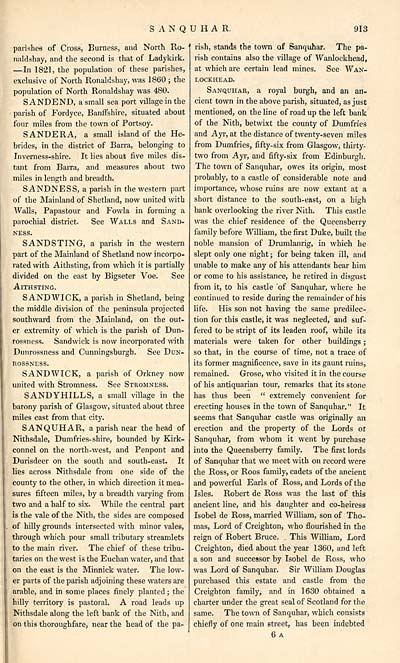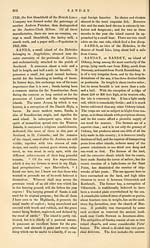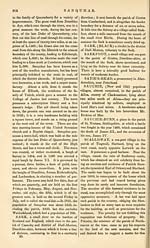Gazetteer of Scotland > Volume 2
(433) Page 913
Download files
Complete book:
Individual page:
Thumbnail gallery: Grid view | List view

SANQUHAR.
913
parishes of Cross, Burness, and North Ro-
naldshay, and the second is that of Ladykirk.
— In 1821, the population of these parishes,
exclusive of North Ronaldshay, was 1860 ; the
population of North Ronaldshay was 480.
SANDEND, a small sea port village in the
parish of Fordyce, Banffshire, situated about
four miles from the town of Portsoy.
SANDER A, a small island of the He-
brides, in the district of Barra, belonging to
Inverness-shire. It lies about five miles dis-
tant from Barra, and measures about two
miles in length and breadth.
SANDNESS, a parish in the western part
of the Mainland of Shetland, now united with
Walls, Papastour and Fowla in forming a
parochial district. See Walls and Sand-
NESS.
SAND STING, a parish- in the western
part of the Mainland of Shetland now incorpo-
rated with Aithsting, from which it is partially
divided on the east by Bigseter Voe. See
Aithsting.
SANDWICK, a parish in Shetland, being
the middle division of the peninsula projected
southward from the Mainland, on the out-
er extremity of which is the parish of Dun-
rossness. Sandwick is now incorporated with
Dunrossness and Cunningsburgh. See Dun-
ROSSNESS.
SANDWICK, a parish of Orkney now
united with Stromness. See Stromness.
SANDYHILLS, a small village in the
barony parish of Glasgow, situated about three
miles east from that city.
SANQUHAR, a parish near the head of
Nithsdale, Dumfries- shire, bounded by Kirk-
connel on the north-west, and Penpont and
Durisdeer on the south and south-east. It
lies across Nithsdale from one side of the
county to the other, in which direction it mea-
sures fifteen miles, by a breadth varying from
two and a half to six. While the central part
is the vale of the Nith, the sides are composed
, of hilly grounds intersected with minor vales,
through which pour small tributary streamlets
to the main river. The chief of these tribu-
taries on the west is the Euchan water, and that
on the east is the Minnick water. The low-
er parts of the parish adjoining these waters are
arable, and in some places finely planted ; the
hilly territory is pastoral. A road leads up
Nithsdale along the left bank of the Nith, and
on this thoroughfare, near the head of the pa-
rish, stands the town of Sanquhar. The pa-
rish contains also the village of Wanlockhead,
at which are certain lead mines. See Wan-
lockhead.
Sanquhar, a royal burgh, and an an-
cient town in the above parish, situated, as just
mentioned, on the line of road up the left bank
of the Nith, betwixt the county of Dumfries
and Ayr, at the distance of twenty-seven miles
from Dumfries, fifty-six from Glasgow, thirty-
two from Ayr, and fifty-six from Edinburgh.
The town of Sanquhar, owes its origin, most
probably, to a castle of considerable note and
importance, whose ruins are now extant at a
short distance to the south-east, on a high
bank overlooking the river Nith. This castle
was the chief residence of the Queensberry
family before William, the first Duke, built the
noble mansion of Drumlanrig, in which he
slept only one night ; for being taken ill, and
unable to make any of his attendants hear him
or come to his assistance, he retired in disgust
from it, to his castle 'of Sanquhar, where he
continued to reside during the remainder of his
life. His son not having the same predilec-
tion for this castle, it was neglected, and suf-
fered to be stript of its leaden roof, while its
materials were taken for other buildings ;
so that, in the course of time, not a trace of
its former magnificence, save in its gaunt ruins,
remained. Grose, who visited it in the course
of his antiquarian tour, remarks that its stone
has thus been " extremely convenient for
erecting houses in the town of Sanquhar." It
seems that Sanquhar castle was originally an
erection and the property of the Lords ot
Sanquhar, from whom it went by purchase
into the Queensberry family. The first lords
of Sanquhar that we meet with on record were
the Ross, or Roos family, cadets of the ancient
and powerful Earls of Ross, and Lords of the
Isles. Robert de Ross was the last of this
ancient line, and his daughter and co-heiress
Isobel de Ross, married William, son of Tho-
mas, Lord of Creighton, who flourished in the
reign of Robert Bruce. This William, Lord
Creighton, died about the year 1360, and left
a son and successor by Isobel de Ross, who
was Lord of Sanquhar. Sir William Douglas
purchased this estate and castle from the
Creighton family, and in 1630 obtained a
charter under the great seal of Scotland for the
same. The town of Sanquhar, which consists
chiefly of one main street, has been indebted
6a
913
parishes of Cross, Burness, and North Ro-
naldshay, and the second is that of Ladykirk.
— In 1821, the population of these parishes,
exclusive of North Ronaldshay, was 1860 ; the
population of North Ronaldshay was 480.
SANDEND, a small sea port village in the
parish of Fordyce, Banffshire, situated about
four miles from the town of Portsoy.
SANDER A, a small island of the He-
brides, in the district of Barra, belonging to
Inverness-shire. It lies about five miles dis-
tant from Barra, and measures about two
miles in length and breadth.
SANDNESS, a parish in the western part
of the Mainland of Shetland, now united with
Walls, Papastour and Fowla in forming a
parochial district. See Walls and Sand-
NESS.
SAND STING, a parish- in the western
part of the Mainland of Shetland now incorpo-
rated with Aithsting, from which it is partially
divided on the east by Bigseter Voe. See
Aithsting.
SANDWICK, a parish in Shetland, being
the middle division of the peninsula projected
southward from the Mainland, on the out-
er extremity of which is the parish of Dun-
rossness. Sandwick is now incorporated with
Dunrossness and Cunningsburgh. See Dun-
ROSSNESS.
SANDWICK, a parish of Orkney now
united with Stromness. See Stromness.
SANDYHILLS, a small village in the
barony parish of Glasgow, situated about three
miles east from that city.
SANQUHAR, a parish near the head of
Nithsdale, Dumfries- shire, bounded by Kirk-
connel on the north-west, and Penpont and
Durisdeer on the south and south-east. It
lies across Nithsdale from one side of the
county to the other, in which direction it mea-
sures fifteen miles, by a breadth varying from
two and a half to six. While the central part
is the vale of the Nith, the sides are composed
, of hilly grounds intersected with minor vales,
through which pour small tributary streamlets
to the main river. The chief of these tribu-
taries on the west is the Euchan water, and that
on the east is the Minnick water. The low-
er parts of the parish adjoining these waters are
arable, and in some places finely planted ; the
hilly territory is pastoral. A road leads up
Nithsdale along the left bank of the Nith, and
on this thoroughfare, near the head of the pa-
rish, stands the town of Sanquhar. The pa-
rish contains also the village of Wanlockhead,
at which are certain lead mines. See Wan-
lockhead.
Sanquhar, a royal burgh, and an an-
cient town in the above parish, situated, as just
mentioned, on the line of road up the left bank
of the Nith, betwixt the county of Dumfries
and Ayr, at the distance of twenty-seven miles
from Dumfries, fifty-six from Glasgow, thirty-
two from Ayr, and fifty-six from Edinburgh.
The town of Sanquhar, owes its origin, most
probably, to a castle of considerable note and
importance, whose ruins are now extant at a
short distance to the south-east, on a high
bank overlooking the river Nith. This castle
was the chief residence of the Queensberry
family before William, the first Duke, built the
noble mansion of Drumlanrig, in which he
slept only one night ; for being taken ill, and
unable to make any of his attendants hear him
or come to his assistance, he retired in disgust
from it, to his castle 'of Sanquhar, where he
continued to reside during the remainder of his
life. His son not having the same predilec-
tion for this castle, it was neglected, and suf-
fered to be stript of its leaden roof, while its
materials were taken for other buildings ;
so that, in the course of time, not a trace of
its former magnificence, save in its gaunt ruins,
remained. Grose, who visited it in the course
of his antiquarian tour, remarks that its stone
has thus been " extremely convenient for
erecting houses in the town of Sanquhar." It
seems that Sanquhar castle was originally an
erection and the property of the Lords ot
Sanquhar, from whom it went by purchase
into the Queensberry family. The first lords
of Sanquhar that we meet with on record were
the Ross, or Roos family, cadets of the ancient
and powerful Earls of Ross, and Lords of the
Isles. Robert de Ross was the last of this
ancient line, and his daughter and co-heiress
Isobel de Ross, married William, son of Tho-
mas, Lord of Creighton, who flourished in the
reign of Robert Bruce. This William, Lord
Creighton, died about the year 1360, and left
a son and successor by Isobel de Ross, who
was Lord of Sanquhar. Sir William Douglas
purchased this estate and castle from the
Creighton family, and in 1630 obtained a
charter under the great seal of Scotland for the
same. The town of Sanquhar, which consists
chiefly of one main street, has been indebted
6a
Set display mode to: Large image | Transcription
Images and transcriptions on this page, including medium image downloads, may be used under the Creative Commons Attribution 4.0 International Licence unless otherwise stated. ![]()
| Gazetteers of Scotland, 1803-1901 > Gazetteer of Scotland > Volume 2 > (433) Page 913 |
|---|
| Permanent URL | https://digital.nls.uk/97436018 |
|---|
| Description | Volume II: Glenbanchor to Zetland. |
|---|---|
| Attribution and copyright: |
|
| Description | By Robert Chambers and William Chambers. Glasgow: Blackie & Son, 1838. 2 volumes. |
|---|---|
| Shelfmark | NF.1461.g.7 |
| Additional NLS resources: | |

